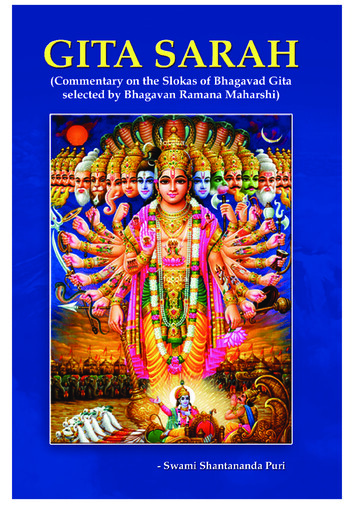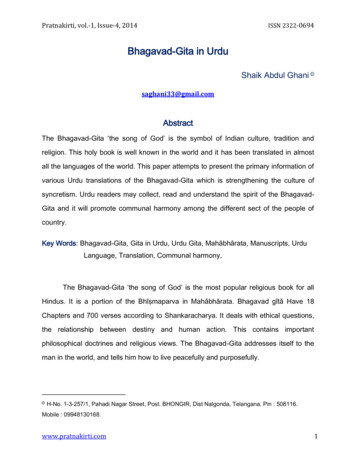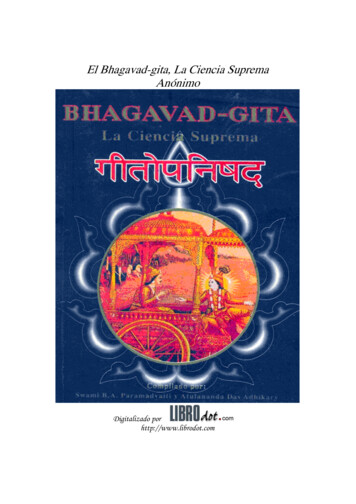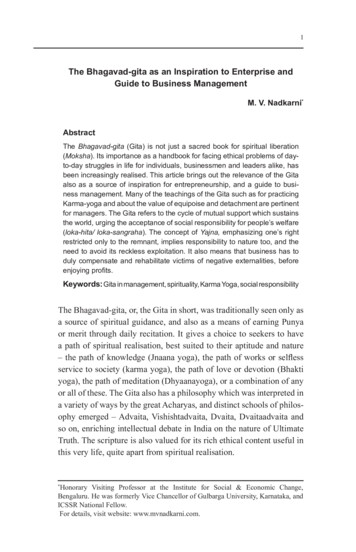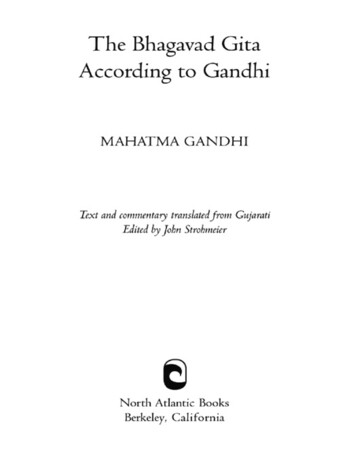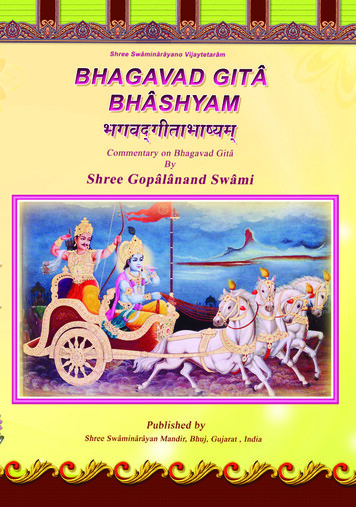
Transcription
BHAGAVAD GITÂ BHÂSHYAM1 x Îìx è¼ c²} ìBHAGAVAD GITÂBHÂSHYAM
2BHAGAVAD GITÂ BHÂSHYAM
BHAGAVAD GITÂ BHÂSHYAM3ContentsBlessings of Mahant Swâmi . . . . . . . . . . . . . . . . . . . . . . . . . . . . . . .4Analysis I . . . . . . . . . . . . . . . . . . . . . . . . . . . . . . . . . . . . . . . . . . . . . .7Analysis II . . . . . . . . . . . . . . . . . . . . . . . . . . . . . . . . . . . . . . . . . . . .15Analysis III . . . . . . . . . . . . . . . . . . . . . . . . . . . . . . . . . . . . . . . .17Analysis IV. . . . . . . . . . . . . . . . . . . . . . . . . . . . . . . . . . . . . . . . . . . . .19Life of Sadguru Swâmi Shree Gopâlânanda Muni . . . . . . . . . . . . .20List of Abbreviations. . . . . . . . . . . . . . . . . . . . . . . . . . . . . . . . . . . 23Summary of Gitâ Chapters. . . . . . . . . . . . . . . . . . . . . . . . . . . . . . 24Gitâ Bhâshya of Sadguru Shree Gopâlânanda Muni . . . . . . . . . .33Chapter 1 - Lamenting the Consequence of War . . . . . . . . . . . . . . . . 35Chapter 2 - The Yoga of Knowledge . . . . . . . . . . . . . . . . . . . . . . . . . 68Chapter 3 - The Yoga of Action . . . . . . . . . . . . . . . . . . . . . . . .143Chapter 4 - The Yoga of Renunciation of Action in Knowledge . . . 196Chapter 5 - Yoga of True Renunciation . . . . . . . . . . . . . . . . . . . . . . . 242Chapter 6 - Yoga of Meditation . . . . . . . . . . . . . . . . . . . . . . . . . . . .274Chapter 7 - Yoga of Knowledge and Realization . . . . . . . . . . . . .320Chapter 8 - The Yoga of the Imperishable Brahma . . . . . . . . . . . .352Chapter 9 - Confidential Knowledge of the Ultimate Truth . . . . .385Chapter 10 - The Yoga of Divine Manifestations . . . . . . . . . . .421Chapter 11 - The Vision of the Universal Form . . . . . . . . . . . .455Chapter 12 - The Yoga of Devotion . . . . . . . . . . . . . . . . . . . 505Chapter 13 - Differentiation Between the Known and the Knower . .522Chapter 14 - The Three Qualities of Material Nature . . . . . . . . . .559Chapter 15 - Realization of the Ultimate Truth . . . . . . . . . . . . . . 586Chapter 16 - The Divine and Demoniac Natures . . . . . . . . . . . . . 613Chapter 17 - The Three Divisions of Faith . . . . . . . . . . . . . . . . . 636Chapter 18 - Final Revelation of the Ultimate Truth . . . . . . . . . . 661Glossary . . . . . . . . . . . . . . . . . . . . . . . . . . . . . . . . . . . . . . . .737Index of Sanskrit Verses . . . . . . . . . . . . . . . . . . . . . . . . . . . .749
4BHAGAVAD GITÂ BHÂSHYAMBlessings of Mahant SwâmiIn the Shikshâpatri, Lord Shree Swâminârâyana has acknowledged and accepted eight sacred scriptures as authoritative, and has ordered His followers to strictly adhere to them.The Shreemad Bhagavad Gitâ is indeed the direct manifestationof the divine voice of Bhagavân. Its greatness and glory are boundlessand immeasurable. It is impossible for anyone to describe it properly inreality. Its greatness and glory has been sung at many places in the Itihâsas(historical epics), Purânas (ancient sacred narratives), and other scriptures. However, all these praises put together fall short in representing thegreatness and glory of the Shreemad Bhagavad Gitâ in total. The Gitâ isa supreme Shâstra containing the preaching of Lord Shree Krishna to Hisdevotee Arjuna.The essence of all the Vedas have been brought together in it. Ithas been composed in such a simple and beautiful manner that even aftera small amount of study a person may grasp the basic principles. But itstrue purport are so deep, so secret and so profound that even a lifetime ofcontinuous study and contemplation would not be enough to reach itsactual depth. Everyday new emotions, new feelings and new insightskeep arising from within the Gitâ, and as a result it remains ever fresh andattractive. If a person, endowed with faith and devotion, were to contemplate upon it with a focused mind, the supreme secrets contained in eachand every word would be revealed directly. The manner in whichBhagavân’s various virtues, splendor, essential truths, mysteries, modesof worship, as well as the description of Karma (action) and Gnyâna(knowledge) have all been revealed in this scripture, is rarely found in anyother. The Bhagavad Gitâ is one incomparable and matchless holy scripture in which there is not a single word which is devoid of true teaching.There is not a single word in the Gitâ which could be called baseless,disagreeable or not illuminating. Whatever has been stated in it is theutmost truth. To think of the possibility of there being anything disagreeable, baseless or false in the words of Bhagavân, who is the manifestationof truth itself, would be disrespectful to His utterances.
BHAGAVAD GITÂ BHÂSHYAM5The Gitâ is merged with every Shâstra. It would not be an exaggeration to call it the treasure-house of all the Shâstras. If one acquiresthe knowledge of the Gitâ comprehensively, one would automatically getthe true knowledge of all the Shâstras for which there would be no needto make a separate effort.Hence, among the eight Shâstras declared as His favorites, LordShree Swâminârâyana, has duly included the Gitâ with great esteem andveneration. Along with this, He has commanded His Bhaktas (devotees)to study, teach and listen to these eight Shâstras.Explaining further, He says that the two commentaries written byShree Râmânujâchârya, one on the Vyâs Sutras (Brahma Sutras) calledthe Shree Bhâshya, and the other on the Shreemad Bhagavad Gitâ, calledthe Gitâ Bhâshya, are both Adhyâtma Shâstras or spiritual scriptures pertaining to Paramâtmâ (the Supreme Lord) and the Âtmâ (the Self or thesoul). In order to elucidate and make clear the tenets of Shree Krishna ascontained in the Gitâ, Shree Hari’s contemporary, the extremely learnedYogirâj Shree Gopâlânanda Swâmi, has written a Bhâshya on ShreemadBhagavad Gitâ. At many places in his Bhâshya, Swâmi has made comments such as ‘Shree Râmânujâchârya has spoken thus’ or ‘Such is thedoctrine or tenet of Shree Râmânujâchârya.’ By means of such references, the doctrines or tenets of the Paramguru (supreme preceptor) ShreeRâmânujâchârya have been truly and properly accepted and given dueassent.The very first edition of Shree Gopâlânanda Swâmi’s Gitâ Bhâshya,along with its Gujarati translation, was published with the helpful guidanceof the Shree Lakshmi-Nârâyandev Temple, Vadatâl. Through the yearsas the number devotees residing in England,America, Australia, Africaand other places have increased, there is a growing demand of scripturestranslated into English. Living abroad, new generation devotees find readingSanskrit, Hindi and Gujarati difficult. So Shree Swâminârâyana MandirBhuj has taken up the initiative of publishing Shree Gopâlânanda Swâmi’sGitâ Bhâshya along with its English translation. This publication shouldopen up new passages to spiritual knowledge for many devotees who are
6BHAGAVAD GITÂ BHÂSHYAMserious about understanding the eternal elements.It gives us great pleasure in publishing the English translation ofthe Gitâ Bhâshya of Shree Gopâlânanda Muni. We humbly request thatdevotees acquire this divine scripture and study it attentively in order toexpand the knowledge of the SupremeAlmighty Lord Shree Krishna andto strengthen one’s faith in Him.We are grateful to all the devotees who have helped in any way inbringing this publication to print. The actual task of translating the Sanskrit text of the Gitâ Bhâshya into English is indeed very onerous. Thevery learned scholars have invested great effort and time in translating theSanskrit texts as accurately as possible. We would like to express ourappreciation to you all and pray at the feet of Lord Nar-Nârâyandev thatHe may give you the strength to partake in such other virtuous deeds andgrant you His divine bliss.Jay Shree SwâminârâyanaMahant Sadguru Purâni Swâmi Dharmanandan DâsjiShree Swâminârâyana Mandir, Bhujf
BHAGAVAD GITÂ BHÂSHYAM7Analysis IThe Significance of the GitâThe Gitâ is a fathomless ocean of knowledge. It is filled with avast treasure of spiritual knowledge that is unlimited and never-ending.Many great scholars and souls, who are the seers of truth, find that theirvoices are dulled, their speech muted and their language inadequate, whenthey attempt to comprehend the Gitâ’s truths. This is because BhagavânShree Krishna alone knows the full extent of all its hidden secrets, mysteries and doctrines.Just as pearls and jewels can be collected from the ocean only bydiving deep into it, similarly, if those desirous of seeking knowledge divedeep into the ocean of the Gitâ, they will obtain a never ending collectionof wonderful gems of knowledge.After due contemplation it becomes clear that the objective of theGitâ is to turn or guide those Jivas (souls) who have been fascinated in thedeep ocean of worldly life since time immemorial towards the Paramâtmâ(Supreme Lord). For this purpose, such means have been mentioned inthe Gitâ, which enable human beings to attain the Lord, even as theycontinue to discharge their obligatory duties in life.The Gitâ reveals the most extraordinary skills or means which areuseful in practical life for securing the highest object. Rising above theperceptions of diversified modes of existence with the mind focused onthe Paramâtmâ, remaining ever steady in that state, not accepting the reality of anyone other than the one Vâsudeva, who is the embodiment ofinfinite truth (B.G. 13.30), is ‘Sânkhyanishthâ’ (being established in theSânkhya discipline). It is also called ‘Gnyâna Yoga’ (the Yoga of knowledge) or ‘Karmasannyâsa’ (the renunciation of action).Believing that everything belongs to Bhagavân, viewing successand failure with equanimity, abandoning attachment and expectation offruits, performing all ordained duties and actions according to the commands of Bhagavân (B.G. 2.47-51) or endowed with faith and devotion,
8BHAGAVAD GITÂ BHÂSHYAMtaking complete refuge in Bhagavân with one’s mind, speech and body,and then meditating upon the form of Bhagavân together with His names,virtues, and powers (B.G. 6.47) is ‘Yoganishthâ’ (being established inKarmaYoga). This has been referred to variously by Bhagavân as SmatvaYoga (the Yoga of equanimity), Buddhi Yoga (the Yoga of wisdom),Tadartha Karma (Karma Yoga oriented to attain the same), MadarthaKarma (Karma Yoga for attaining Bhagavân), Sâttvika Tyâg (the puresacrifice), etc.Bhakti (devotion) exists in Yoganishthâ, whether in the ordinaryor special context. The Yoganishthâ mentioned in the Gitâ is not devoid ofBhakti. Even where there is no specific mention of Bhakti or Bhagavân(B.G. 2.47-51), the question of obedience of Bhagavân’s commands isalways present, and from this viewpoint, Bhakti does exist in such placesalso. For the performance or accomplishment of Gnyânanishthâ (beingestablished in knowledge), the realization of the One and only Paramâtmâis necessary. Although there are many divisions of reality in GnyânaYoga,it may divided into three main parts - Brahma, Universe and Jiva.Devotion in the GitâIn the Gitâ, Bhakti (devotion), Gnyâna (knowledge) and Karma(action) have been elaborated with clear distinction. However, Arjunawas Bhagavân’s devotee, and therefore Bhagavân has largely advisedhim to follow Karma Yoga in which Bhakti is predominant.At some places, injunctions have been given to perform Karma(actions) alone. But in these instances also, we should establish the intimate connection with Bhakti by logical inferences from other places.Bhagavân’s command to Arjuna to go to a master and learn knowledgefrom him, as given in chapter 4, verse 34, was only to remind Arjunaabout the existence of such a traditional system and also to suitably caution him. In truth the intention of Bhagavân was not to send Arjuna tosome Gnyâni, nor did Arjuna go anywhere and acquire any knowledge.Also, examination of the Gitâ from start to end reveals that Sharanâgati(the concept of taking total refuge in Bhagavân) is the Gitâ’s final conclusion. Although the teaching in the Gitâ begins with the words ‘ashochyân
BHAGAVAD GITÂ BHÂSHYAM9anvashochaha tvam’ (‘you grieve over those who should not be grievedfor’) (B.G. 2.11), this deliberate commencement of Bhagavân’s speechlies in Arjuna’s own prior utterance ‘kârpanyadoshopahatsvabhâvaha’(‘my fighting spirit is marred due to the taint of faint heartedness ’) (B.G.2.7). The sentiment of Sharanâgati is made clear by the word ‘Prapannam’therein. Therefore, on the basis of Sharanâgati alone, Bhagavân has summedup the conclusion of His teachings with the words ‘sarva dharmânparityajya’ (‘completely relinquishing all Dharmas onto Me ) (B.G.18.66).Effectively all chapters in the Gitâ are associated with Bhakti. Forinstance, verse 61 of chapter 2; verse 30 of chapter 3; verse 11 of chapter4; verse 29 of chapter 5; verse 47 of chapter 6; verse 14 of chapter 7;verse 14 of chapter 8; verse 34 of chapter 9; verse 9 of chapter 10; verse54 of chapter 11; verse 2 of chapter 12; verse 10 of chapter 13; verse 26of chapter 14; verse 19 of chapter 15; verse 1 of chapter 16; verse 27 ofchapter 17; verse 66 of chapter 18.In this way, the context of Bhakti can be found in every chapter.Chapters 7 to 12 are full of matter pertaining to Bhakti Yoga and thereforethese six chapters are regarded as mainly devoted to Bhakti.Similarly, the concept of Gnyâna (knowledge) can be found inmany chapters. For instance, verse 29 of chapter 2; verse 28 of chapter3; verse 24 of chapter 4; verse 13 of chapter 5; verse 29 of chapter 6;verse 13 of chapter 8; verse 15 of chapter 9; verse 3 of chapter 12; verse34 of chapter 13; verse 19 of chapter 14; verse 49 of chapter 18.Even amongst the chapters mentioned above, in chapters 2, 5,13, 14 and 18 especially, many verses dealing with knowledge can befound.Just as the essence of Bhakti and Gnyâna have been revealed inthe Gitâ so eloquently, so has the essence of Karma been revealed comprehensively. Verses 39 to 53 of chapter 2; verses 4 to 35 of chapter 3;verses 13 to 32 of chapter 4 and verses 2 to 7 of chapter 5, elaborateupon Karma. Amongst these chapters, especially in verse 47 of chapter 2and verses 16 to 18 of chapter 4, the secrets of Karma have been dis-
10BHAGAVAD GITÂ BHÂSHYAMcussed clearly. Apart from this, there are references to Karma in otherchapters as well. It is obvious from this that the Gitâ does not contain thedescription of devotion alone, but with the combination of knowledge andaction have been comprehensively and authoritatively explained therein.Recognition of the GunasThe Gitâ explains how to recognize substances, thoughts or feelings, and attachments to actions which belong to one of the three Gunas(the three categories into which every quality, characteristic or propertybelonging to all created things can be divided into), namely Sattva (thatquality of Prakriti or nature which leads to happiness and harmony), Rajas(that quality of Prakriti which leads to restless activity), orTamas (that quality of Prakriti which leads to indolence and inertia). This is as follows 1. That thought, emotion or action which is not connected withany self-interest or selfishness; which does not have any attachment; andwhose objective is the realisation of Bhagavân, should be understood asbeing Sâttvika (having the Sattva Guna).2. That thought, emotion or action which is connected with greed,selfishness and obsession; and whose fruit gives momentary happinessleading to sorrow as the end result, should be understood as Râjasika(having the Rajas Guna).3. That thought, emotion or action which contains cruelty, confusion, negligence; and whose fruit is sorrow and ignorance, should be understood as Tâmasika (having the Tamas Guna).Commentaries on the GitaMany Âchâryas have explained and expounded the various topics of the Gitâ from their own individual viewpoints. Amongst them, themain Âchâryas are Shree Shankarâchârya, Shree Râmânujâchârya andShree Madhvâchârya.The Gnyâna Yoga of Shree ShankarâchâryaShree Shankarâchârya is mainly a proponent of Gnyâna Yoga. InIndian literature, three main means for attaining Moksha (final liberation)
BHAGAVAD GITÂ BHÂSHYAM11have been duly accepted, namely Gnyâna, Karma and Upâsanâ. Gnyânais linked with the brain, Karma is linked with the Indriyas (the senseorgans) and Upâsanâ is linked with the heart. This is also known as‘knowing’, ‘willing’ and ‘feeling’ in the English language. The path ofGnyâna is called Gnyâna Yoga, the path of Karma is called Karma Yoga,and the path of Upâsanâ is called Bhakti Yoga. Shree Shankarâchâryawas an exponent of Advaita (non-dualism). His contention is that theuniverse is unreal or illusory, only Brahma is real; the Âtmâ is fundamentally Brahma alone; and the plurality or diversity we perceive is due toignorance and Mâyâ (cosmic illusion).If it is true that the root cause of all our evils and troubles lies inignorance and Mâyâ, then it follows that apart from Gnyâna there is noother remedy for all our problems. This is the reason why, according toShree Shankarâchârya’s commentary, the main or well established topicof the Gitâ is ‘Gnyâna Yoga’. Karma is unavoidable but it is not so important, as Gnyâna is the most important. Karma is done only to abandonKarma for Sannyâs (renunciation). With regard to obtaining release fromKarma, Shree Shankarâchârya’s contention is that in chapter 4, verse 37,it is mentioned – ‘gnyânagnissarvakarmâni bhasmasâtkurute arjuna’(In the fire of knowledge all Karmas are reduced to ashes, OArjuna!). Inthe same way, in chapter 4, verse 33, it is stated, ‘sarvam karmâkhilampartha gnyâne parisamâpyate’ (All actions without exception, OArjuna,culminate in Gnyâna). From this it is proved that the clearly defined topicof the Gitâ is not Karma Yoga but Gnyâna Yoga. As regards to Upâsanâ,Shree Shankarâchârya says that Bhakti is directed towards an entity (withform or shape or attributes), and since Brahma has no particular entity,His Upâsanâ is not possible. It is also not possible to show love or faithand reverence towards Brahma. In short, according to ShreeShankarâchârya, the clearly defined and well established topic of the Gitâis neither Karma Yoga nor Bhakti Yoga, but it is only GnyânaYoga.The Bhakti Yoga of Shree RâmânujâchâryaShree Râmânujâchârya is the proponent of Vishishtâdvaita. Sowhat is Vishishtâdvaita? Shree Râmânujâchârya says that ShreeShankarâchârya’s ‘Advaitavâd’ (doctrine of Advaita) does not conform
12BHAGAVAD GITÂ BHÂSHYAMto the Sutras and is also not conducive to the good of the world andmankind. In other words, the Advaita doctrine, according to ShreeRâmânujâchârya, is not valid. The Jiva (Âtmâ), Ishvara (Parabrahma),and Jagat (the Universe) do not comprise of just one single reality, ratherthey are three separate truths.The three truths - Jiva, Ishvara and Jagat are distinctly differentand eternal or imperishable. The Jiva (sentient being) and Jagat (insentient matter) both form part of Ishvara’s body. Ishvara, endowed withChit (sentient beings) andAchit (insentient or inert matter), is one alone.From Ishvara’s subtle Chit-Achit component arises the gross Chit-Achitcombination, and from the obvious Chit-Achit combination arises the obvious Chit and the obvious Achit separately (‘yat sthula jagat’ or ‘theobvious universe’).In this doctrine, the Jiva as well as the Jagat are considered as thebody of Ishvara. Therefore though this doctrine implies Advaita, Ishvarais accepted as qualified by or distinguished by or endowed with Jiva andthe Jagat. This doctrine is termed as Vishishtâdvaita. Just as the bodyand the Âtmâ appear as one but are actually different from one another, inthe same way, Jagat and Paramâtmâ also appear to be one but are clearlydifferent and distinct from one another. When considering Ishvara, Jivaand Jagat, even with regard to these three, they are both bound together,and at the same time are different from each other just as the Âtmâ and thebody are experienced as being separate and also as being one at the sametime. Shree Râmânujâchârya says that despite being an endowment orqualification of Ishvara, they are separate from Ishvara. The Jiva is notunreal or non-existent. In the state of Mukti (final liberation), it does notdisappear or become extinct.Then what is the nature of the relationship between Ishvara andthe Jiva? Just as the Jiva looks over the body and controls it; in the samemanner, Ishvara looks over the Jiva and controls it. The Paramâtmâ ispresent within the Âtmâ. From this point of view, Ishvara is endowedwith Chit-Achit in a single entity. That is to say the Jiva and the Jagat areregarded as forming the body of Ishvara. Shree Râmânujâchârya’s con-
BHAGAVAD GITÂ BHÂSHYAM13tention is that the well defined and well established principle topic of theGitâ is Bhakti, and not Karma. Ishvara’s compassion towards the Jivacan only arise from the feelings of Bhakti. Karma acts as a support. Thatis why it is said – ‘ishvarah sarvabhutânâm hriddeshe’rjuna tishthati;bhrâmayan sarvabhutâni yantrârudhâni mâyayâ.’ (‘In the heart ofall beings, O Arjuna, resides the Lord, causing them to revolve accordingto their Karma, mounted on a wheel as it were, by His power of Maya.’)(B.G. 18.61). Seated in the hearts of all beings, Ishvara guides and impelsthem. For this reason it is stated – ‘madhyâji mâm namaskuru’ (‘Worship Me and be humble towards Me.’) (B.G.18.65). It is also stated –‘sarvadharmân parityajya mâmekam sharanam vraja’ (‘Relinquishing all Dharmas, take refuge in Me alone.’) (B.G. 18.66).In this manner, by establishing Vishishtâdvaita in place of ShreeShankarâchârya’s Advaita, and Bhakti in place of Sannyâs, ShreeRâmânujâchârya propagated the ‘Bhaktimârga’ (the path of devotion)and he proclaimed that the main topic of the Gitâ is Bhakti Yoga. Like theAdvaita Vedântis, Shree Râmânujâchârya does not accept the concept of‘Nirguna’ (Brahma without attributes), but accepts ‘Saguna’ (Brahma withattributes). Brahma is auspicious and conducive to the good of the devotees.Shree MadhvâchâryaShree Madhvâchârya’s advent was after that of ShreeRâmânujâchârya. He wrote two texts called the ‘Gitâ Bhâshya’ and the‘Gitâ Tâtparya’. With regard to Vishishtâdvaita, his contention was thatto consider Ishvara and the Jiva as mutually different and therefore it isproper and right to consider them both as completely different. Further,he propounded a third doctrine which is called ‘Dvaita Sampradâya’ (tradition of duality). Where there is Dvaita (duality) there is Bhakti, becauseadoration and worship can only be there between two entities. ShreeMadhvâchârya has also acknowledged that the main topic of the Gitâ is‘Bhaktiyoga’. He holds that the Gitâ certainly expounds Karma, but thatis only a means and not that which is to be attained.
14BHAGAVAD GITÂ BHÂSHYAMShree Gopâlânanda SwâmiShree Gopâlânanda Swâmi was the foremost disciple of LordShree Swâminârâyana. He was proficient in the scriptures and Yoga. Hehas expounded and established the ‘Vishishtâdvaita’ doctrine in his GitâBhâshya. Just as Shree Râmânujâchârya has accepted that Jiva, Ishvaraand Jagat (Universe) are different and eternal, Shree Hari has acceptedthe same tenet as per His statement, ‘matam vishistâdvaitam me’ whichShree Gopâlânanda Swâmi has explained in his Gitâ Bhâshya. Therefore,the chief topic of the Gitâ is Bhakti Yoga alone. For this reason, in theVachanâmrut, on the basis of the authority of the Gitâ, Shree Hari hasoften proved that though Ishvara, Jiva and Jagat have separate existence,the Jiva and the Jagat are dependent upon and subject to Ishvara andconstitute the body of Ishvara. The main teaching of the Gitâ is that whilefollowing this doctrine, one should accept that devotion to Ishvara is themeans for Moksha.Shree Shankarâchârya, the proponent of Advaita, discusses various aspects of knowledge in the Gitâ. The proponents of Vishishtâdvaita,Shree Râmânujâchârya, Lord Shree Hari and Shree Gopâlânanda Swâmi,discuss Bhaktiyoga. Further, scholars of the modern age, like LokamanyaTilak, Shree Arvind Ghosh, Bankimchandra Chatterjee, and others holdthat Karma is the main established topic of the Gitâ. In reality, the Gitâ isone unique sacred text which reveals all the different paths. The Gitâshows the path of Bhakti to passionate devotees, the path of knowledgeto Gnyânis and the path of Karma to the adherents of action. Therefore,the Gitâ is not one-sided.Dr. Swâmi Satyaprasâd Dâsji(Vidyâ Varithi,Vedântâchârya)Bhuj -Kutch
BHAGAVAD GITÂ BHÂSHYAM15Analysis IISpecial features of the Gitâ Bhâshya1.Unlike other commentators, the author has elaborately describedAksharadhâma, mainly in the commentary of chapter 8, giving several citations from Svetâsvatara Upanishad, Skanda Purâna, BrahmaVaivarta Purâna, etc., as it occupies a special position in the tenetsof the Sampradâya.2.In chapter 1, verses 16-17, the author has suggested an alternativesplit of the compound word ‘caparâjitah’ - as ‘capa râjitah’ means looking ‘bright with bow’. It is Tat-purusha compound(Samâsa). He has also mentioned the Sandhi (conjoining of words)as ca (and) aprâjitah (undefeated), which is universally accepted.3.The meaning of the term ‘Vikarma’ in chapter 4.17 given by theauthor is quite different from that of Âdi Shankarâchârya, Shridharaand Dr. Râdhâkrishnan and others. According to them Vikarmameans forbidden action. Shree Râmânujâchârya and ShreeGopâlânanda Muni have interpreted it as ‘varied forms of action inrelation to Vedic Karma’.4.In chapter 9, verses 16 to 19, commenting upon the word ‘Prabhava’the author refers to the Vyuha forms, i.e.Aniruddha, Sankarshanaand Pradyumna. In chapter 10, verse 20, in the Shruti passage ‘Iam the origin’, the author mentions Aniruddha along with Brahma.5.In chapter 11, verse 46, the author has described the form of theLord as having two arms instead of four. According to the authorthe term ‘Chaturbhujena’ refers to Lord’s four associates, Nand,Sunand, etc. He has also mentioned the meaning ‘having four arms’(Chaturbhujena) as stated by other commentators.6.Shankarâchârya and Râmânujâchârya have commented upon thestanza 13.2 ‘kshetragnyam cha api mâm viddhi’ elaborately, whileShree Gopâlânanda Muni has commented on it in brief.Shree Gopâlânanda Muni has given different versions of the Gitâ,these below are accepted universally –7.
16BHAGAVAD GITÂ BHÂSHYAM(i). In B.G. 2.9, the adjective ‘Parantapa’ is taken in the vocativecase addressed to Dhritarâshtra, while all others have interpreted itas ‘Parantapah’ in the nominative case qualifyingArjuna.(ii). In 3.10 ‘saha-yagnyaih’ instead of ‘saha-yagnya’(iii). In 18.18 ‘karma-nodana’ instead of ‘karma-codana’(iv). In 18.64 ‘dridha-matih’ instead of ‘dridham-iti’8.Shree Gopâlânanda Muni has written an introduction to almost eachstanza, while other commentators have not done so.9.At places, the author has commented upon those words which areimportant according to him. Therefore the explanation of a fewwords from the stanzas seem to be omitted; for instance stanza4.31 and 18.62.10. In the verse 17.2, the author has mentioned four-fold ‘Shraddhâ’and ‘Gnyâna’, along with three-fold ‘Shraddhâ’ according to Gunaslike ‘Sâttvika’, etc., which are stated in the Gitâ. The forth he hasmentioned as ‘Nirguna Shraddhâ’ and ‘Nirguna Gnyâna’ i.e. ‘abovethe Gunas’, giving reference and citations from Shreemad Bhâgavata.11.Wherever the author defers from Shree Râmânujâchârya, he respectfully mentions and quotes his words; for instance in verse 3.15,the meaning of the word ‘Brahma’ according to Shree GopâlânandaMuni is ‘Veda’ and according to Shree Râmânjâchârya it is ‘physical body’ (constituted of modifications of Prakriti) and Prakriti isdenoted by Brahma, etc.12.Like Shree Râmânujâchârya, the form of the Lord is described bythe author with numerous adjectival phrases such as the controllerof all; prime cause of all causes; the ocean of affection to devotees;devoid of slightest trace of any defect; the ocean of vast, innumerable, unsurpassed benevolent qualities; the ocean of nectar of beauty;having eyes which steal the beauty of a fresh red lotus; who is theobject of worship of all; the loving son of Vâsudeva; the real form ofDharma; etc. Such descriptions are often found in the Bhâshya,and at certain places these are indirectly addressed to his Guru LordSahajânanda Swâmi Himself.Prof. Suman Mâhâdevakar
BHAGAVAD GITÂ BHÂSHYAM17Analysis IIIScholarly Review of the Gitâ BhâshyaLord Shree Swâminârâyana Himself instructed Shree GopâlânandaMuni to write a commentary on Bhagavad Gitâ. As the commentarywritten by Shree Râmânujâchârya was several hundred years old, it wasnecessary to write a fresh commentary to suit the social conditions in thetimes of Lord Shree Swâminârâyana. Shree Gopâlânanda Muni was asound Sanskrit scholar with profound knowledge of Vedânta and philosophy in general. While reading his commentary for undertaking thetask of translating his work, we were highly impressed by his comprehensive knowledge, command over grammar, logic and philosophy. He undertook the assignment with full responsibility of doing justice to ShreeRâmânujâchârya’s Bhâshya of the Bhagavad Gitâ, as well as the sense ofbelonging to the Sampradâya founded by Lord Shree Swâminârâyana.As a result it is noticed that he has often used his grammatical skill to createan altogether different meaning of the same wording. One representativeexample is that of‘satyakis châparâjitah’ (B.G.1.17). The obvious meaningof this line is ‘Satyaki, one who was never defeated’. This meaning is universally accepted. But Shree Gopâlânanda Muni sees a different meaningby splitting the word as Châpa and Râjitah. The resultant meaning is ‘shining with a bow’. This meaning is unique, novel and grammatically soundand does not alter the Gitâ text. However, Shree Gopâlânanda Munidoes not stop there. Sometimes he takes in variant readings also. Thus inthe Gitâ verse, instead of ‘Atimana’ he used ‘Abhimâna’; also, instead of‘Saha-ya
6 BHAGAVAD GITÂ BHÂSHYAM serious about understanding the eternal elements. It gives us great pleasure in publishing the English translation of the Gitâ Bhâshya of Shree Gopâlânanda Muni. We humbly request that devotees acquire this divine scripture and study it attentively in order to
